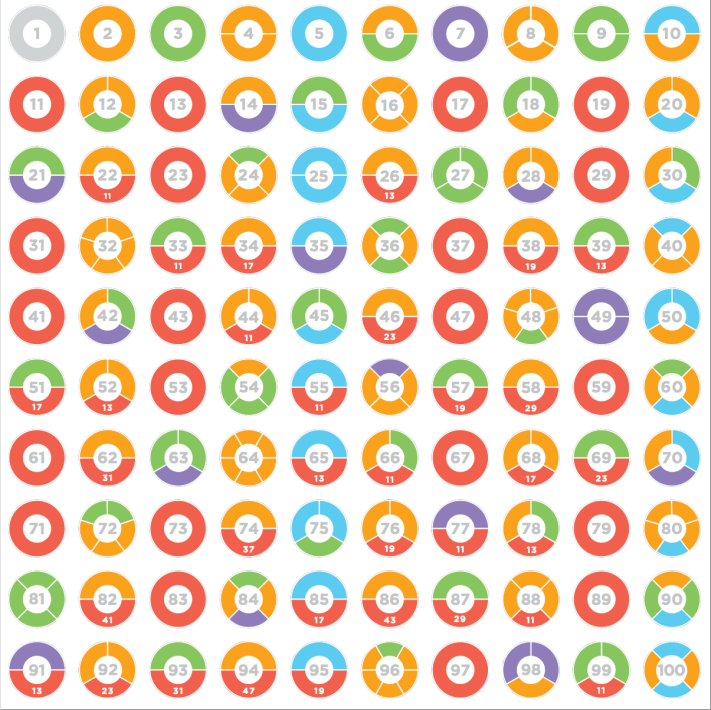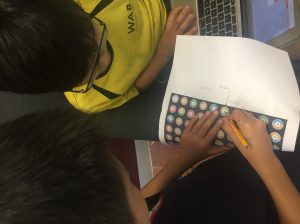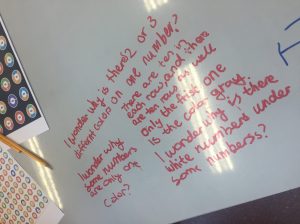Why is it that students always seem to get factor and multiple confused? In my search for an activity to reinforce these terms I came across a hundreds chart (as featured in the excellent TEDtalk by Dan Finkel). It is taken from the game Prime Climb made by the guys at math4love.
 The chart goes up to 100 but we started off with a quick ‘I notice’ brainstorm by looking at the pattern up to 20 as a class. It allowed us to get past the simple – there are circles, there are different colours, the circles have numbers in them.
The chart goes up to 100 but we started off with a quick ‘I notice’ brainstorm by looking at the pattern up to 20 as a class. It allowed us to get past the simple – there are circles, there are different colours, the circles have numbers in them.
I made a variety of printouts available to the students – all downloadable from here. The students worked in groups to look for patterns and make generalizations, recording their ideas on their tables and on the sheets. I also set up a Todays Meet for the groups to share their ideas with the class.
After some time spent exploring the 100s chart we shared our big understandings. We used what we had discovered to make predictions.
For example:
- By just looking at the top row can you draw the circle for 35?
- By using the one student’s statement Start with 2 then double and double and double to get the pattern 2, 4, 8, 16 etc Each time you add an orange section can you predict what 128 will look like?
It was clear from the conversations, comments on the chatboard, notes on tables, annotations on sheets etc that the students were able to identify the patterns but they were struggling to clearly communicate them.
I downloaded the todaysmeet transcript to read through as a class and highlight any mathematical language we could find:
- Any number that can be divided by another number is split with lines
- I wonder why the number 1 is the only number that has a grey shade
- 4 has 2 oranges because if you see orange represents 2 so when there is 2 oranges in the circle then it means 2 times 2 which makes 4
- I wonder if those white lines mean something.
- The number 3 is green, 5 is blue. Since 15 is 3×5, the colour of the circle is green and blue.
- The row with 5 times table, all the circles has at least one blue, because blue represents 5.
- 2 is yellow three is green. So if we do 6×2, 6 has 1 yellow and 1green and 2 has 1 yellow. SO 1 y x (y+gr)= y2=gr1 12 is y2gr1
- Why are there tiny white numbers written in some of the circles?
- I wonder why 2 doesn’t have any lines in the circles since it is a even number.
- If you start at 11, you go down by a diagonal line, all the numbers in the line can by divided by 11
- Numbers in 5th row and 10th row (vertical) all have blue in it.
- I wonder why the first number is grey?
- I think every vertical row has their own main colour. (expect for the numbers in the 10 row)
- All the numbers that have 13 has a red colour
- I counted all of the red numbers and had this pattern: 10, 1, 3, 1, 3,5, 1,5,3,1,3,5,5,1
- I found out that 2 x 4 = 8 and they all have the same colour – orange
- I think all the numbers that can’t be divided at all is red.
- We noticed that is you count down from 10, you could see the pattern is always counting by 10.
- All the plain red numbers are odd.
- The numbers that only have 1 colour are prime numbers
- We wonder that why there’s no gray except for 1
- The numbers that only have 1 section are prime numbers
- All the numbers that are divisible by 2 has orange.
- What is a prime number?
- Is 27 a prime number?
- Prime number is a number that could divide by itself or 1
- Every even number has orange but no odd numbers have orange
- All the numbers that end with 0 has blue and orange
- We found out that is you count down from 1, the number has a 1 at the end
- Every even number has a orange in it because 2 is orange and you can split even numbers in two
- Since 2 is orange, all the even numbers has orange.
- We think that everything is divided with 1 so all the colour of number is gray
- Every number that has a zero or five has a blue in it!
- In the 3 times table there is green
- Every multiple of 7 has purple
- Every multiple of 3 has green.
- 3 has a green and then skip 20 there is green again and skip twenty again, it has green
- All the numbers in the 10th place (except for 10, 20 and 30) is split into 4 lines.
- All of the multiple of 7 have orange in it.
- We wonder why isn’t there any patterns in the 3 sections?
- If you draw a line from 11 diagonally, all of the numbers are multiple of 11.
- 2,3,5,7 are the main numbers, every number else is times one of these numbers. Expect those red numbers.
- The multiple of 6 all have green and orange in it.
- all the multiples of 10 have blue and green in it
- We found out that 2 times 5 makes 10 so that’s yellow and blue. And all of the multiple of 10 has yellow and blue in it
- If the number is a multiples of 10 it has need to have blue and orange.
- Every multiple of 9 have Green inside.
- Because 5 is blue and 2 is orange. 2×5=10
- If you see the row vertically, every other row it’s main colour will be yellow.
- The number that has no line is prime number
- Start with 2 then double and double and double to get the pattern 2, 4, 8, 16 etc Each time you add an orange section.
After checking for understanding of these terms we looked at statements that were unclear or lacking any mathematical language or reasoning.
We took this statement: All the numbers that end with 0 has blue and orange
Everyone understood what this meant but agreed that it didn’t sound very mathematical. After working with partners to rewrite the statement we came up with:
All the multiples of 10 have an orange and a blue section.
We then moved on to reasoning and trying to explain why this would be true.
All the multiples of 10 have an orange and a blue section. This is because the factors of 10 are 2 (orange) and 5 (blue).
And with that statement the time was up. In the next lesson we will explore what the white numbers mean and dig into prime factorization. And, of course, get online to order the game!



What a rich discussion and engagement.